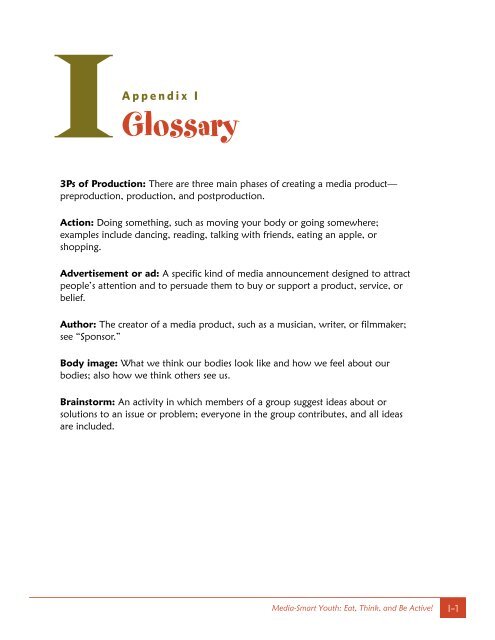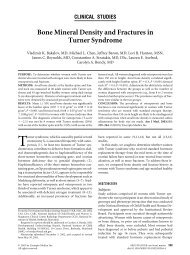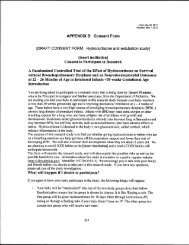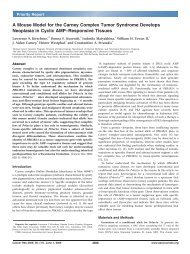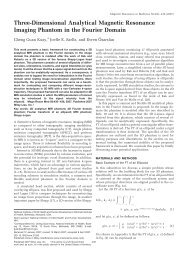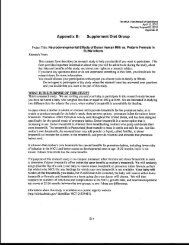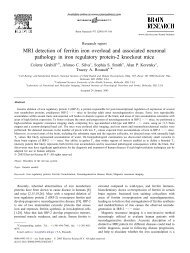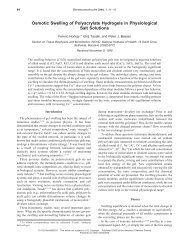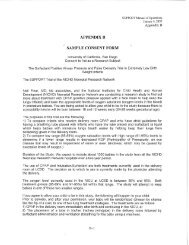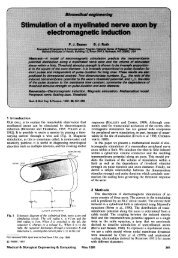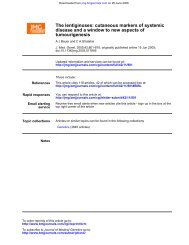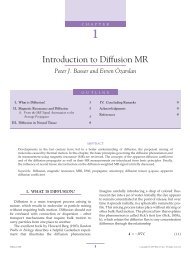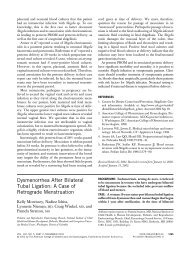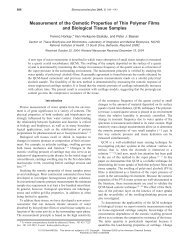You also want an ePaper? Increase the reach of your titles
YUMPU automatically turns print PDFs into web optimized ePapers that Google loves.
I<strong>Appendix</strong>I<strong>Glossary</strong>3Ps of Production: There are three main phases of creating a media product—preproduction, production, and postproduction.Action: Doing something, such as moving your body or going somewhere;examples include dancing, reading, talking with friends, eating an apple, orshopping.Advertisement or ad: A specific kind of media announcement designed to attractpeople’s attention and to persuade them to buy or support a product, service, orbelief.Author: The creator of a media product, such as a musician, writer, or filmmaker;see “Sponsor.”Body image: What we think our bodies look like and how we feel about ourbodies; also how we think others see us.Brainstorm: An activity in which members of a group suggest ideas about orsolutions to an issue or problem; everyone in the group contributes, and all ideasare included.Media-Smart Youth: Eat, Think, and Be Active! I–1
Calcium: A mineral that the body needs to build and maintain strong, healthy bones andteeth, as well as for overall health.♦♦Young people ages 9 to 18 need 1,300 milligrams of calcium every day. 1♦ Calcium is found in a variety of foods.♦ Milk and milk products are the best dietary sources of calcium. 2♦ Other foods, such as dark green leafy vegetables, white beans, and dry roastedalmonds, contain small amounts of calcium.♦ Some foods (for example, soy beverages, orange juice, and bread) are alsocalcium-fortified; see “calcium-fortified.”Calcium-fortified: The addition of calcium to a food that does not naturally containcalcium or high levels of calcium, such as calcium added to orange juice, breakfast cereals,and bread.Calorie: A unit of energy.♦ The number of calories in a food is a measure of how much potential energyit contains.♦ Our bodies use the energy in food to power all our body functions—breathing,thinking, digesting, running, sleeping, cell division, and everything else.♦ There are 4 calories per gram of protein, 4 calories per gram of carbohydrate, and9 calories per gram of fat.Carbohydrate: One of the categories of nutrients found in food (the others are fat,protein, water, vitamins, and minerals); provides the fuel your body needs to do itswork; can be simple (like those found in sugars) or complex (like those found in grains,potatoes, or peas); includes dietary fiber, which is also a type of carbohydrate, but it isnot a source of fuel; see “Dietary fiber.”Creative plan: A tool that professional media producers use to make decisions beforethey start production of their actual media project; a plan of action covering all aspectsof the production.Dietary fiber: A kind of carbohydrate that is not digested by the body; helps movefood through and out of the digestive tract and helps to keep the digestive tract healthy;found only in plant foods (such as whole grains, fruits, vegetables, beans, and nutsand seeds).1 Committee to Review Dietary Reference Intakes for Vitamin D and Calcium, Food and Nutrition Board, Institute of Medicine. (2010). DietaryReference Intakes for Calcium and Vitamin D. Washington, DC: National Academy Press.2 U.S. Department of Agriculture, U.S. Department of Health and Human Services. (2010). Dietary Guidelines for Americans, 2010. RetrievedOctober 12, 2012, from http://health.gov/dietaryguidelines/dga2010/DietaryGuidelines2010.pdf.I–2
Dietary Guidelines for Americans: A set of dietary recommendations jointly issuedby the U.S. Department of Health and Human Services and the U.S. Departmentof Agriculture; the guidelines (http://health.gov/dietaryguidelines/dga2010/DietaryGuidelines2010.pdf) are the cornerstone of federal nutrition policies and nutritioneducation activities.Digital media: A form of electronic media in which data are stored in digital (asopposed to analog) format.Endcaps: Display cases at the ends of the supermarket aisles.Entertain: To amuse or keep someone’s interest and attention; one of the three mainpurposes of media.Fats: One of the categories of nutrients found in food (the others are carbohydrates,protein, water, vitamins, and minerals). Fats provide more calories per gram than anyother calorie source—9 calories per gram.♦ Fats supply calories and essential fatty acids, and help in the absorption of the fatsolublevitamins A, D, E, and K.♦ Dietary fats include fatty acids, triglycerides, and cholesterol. The main types offatty acids are saturated, trans, monounsaturated, and polyunsaturated fatty acids.♦ Fats are found in both plant and animal foods. Fat from animal foods is found inmeats, poultry, seafood, eggs, and dairy products.♦♦ Fat from plant foods comes in liquid form as “oils.” Oils are extracted from plantssuch as canola, corn, olives, peanuts, safflower, soybeans, and sunflowers.♦ Solid fats are found in fatty meats, fried poultry, whole milk dairy foods, butter,lard, and cream.♦ Limit intakes of solid fats because they are higher in saturated fatty acids and/ortrans fat than oils. Choose lean meats, poultry, and seafood; eggs; and fat-free andlow-fat dairy products instead.♦ Replace solid fats with oils where possible. When cooking, use vegetable oilsinstead of butter, lard, and stick margarine.General action: A broad, sweeping idea or response, such as “eat healthy” or “get morephysical activity”; the opposite of specific action; see “Specific action.”Helper: Something that makes it easier for a person to do something; for example,having a bowl of fresh fruit on the kitchen counter could be a helper for choosinghealthful snacks.Impulse buy: The items placed near the cash register in a grocery store; usually itemssuch as magazines, candy, and gum.I–3
Infomercial: A 30- to 60-minute program designed to sell a product or service.Inform: To give information to someone; one of the three main purposes of media.Ingredients: The pieces or components of something; for example, the individual foodsand spices in a recipe are the ingredients.Ingredient list: The list on a food package that states what is in the food, including anynutrients that have been added; listed in descending order by weight, meaning the firstitem listed is the largest amount and the last item listed is the smallest.Jingle: A short, catchy song used in an advertisement.Logo: A symbol that stands for a company, organization, institution, or agency and itsbeliefs; often put on products (such as clothing or food packages); designed to make aperson recognize that a product is made by a particular company.Media: Ways of communicating or expressing information or ideas to people; forexample, newspapers, television, radio, billboards, letters, telephones, and the Internet.Message: The specific point or statement made by a media product, such as the mainidea of a television advertisement or a key point in a news story.Minerals: One of the categories of nutrients found in food (the others arecarbohydrates, fat, protein, water, and vitamins).♦♦Our bodies need certain minerals to function properly. Because our bodies don’tmake them, we must get them from food.♦ Examples include calcium, iron, and zinc.Nutrients: Substances that bodies need to grow, have energy, and stay healthy; classifiedin six groups: protein, fats, carbohydrates, vitamins, minerals, and water.Nutrition: The process by which we take in and use food to grow, develop,and function.Nutrition Facts label: The label found on packaged foods and drinks; providesinformation about the calorie and nutrient content based on a specified serving size,which is also defined on the label.I–4
Obstacle: Something that makes it hard or harder for a person to do something; forexample, “not wanting to get sweaty” could be an obstacle to being physically active.Omission: To leave out something or fail to include a specific fact or pieceof information.Osteoporosis: A condition in which bones become brittle, compress, and break easily,resulting from not getting or having enough calcium and other minerals; weight-bearingactivity and getting enough calcium all through life are two important ways to helpprevent osteoporosis.Percent Daily Value (%DV): The section of a food label that gives the food’snutritional content based on a 2,000-calorie diet.♦♦The value of the nutrient is given in percentages of daily need.♦ You can use this to quickly compare foods and see how the amount of a nutrientin a serving of food fits into a 2,000-calorie diet.Persuade: To convince someone to do or think something; one of the three mainpurposes of media.Physical activity: Anything that gets a body moving; for example, sweeping, walkingthe dog, riding a bike to school, carrying the groceries, jogging, or playing basketball.Point of view: The way a person looks at an event or situation, or the perspective fromwhich something is considered.Postproduction: All the activities that take place after creating a production to make thefinal version, such as editing a videotape or showing the production to others.Preproduction: All the things a person does to get ready to create a media production,such as gathering supplies and equipment, deciding on an audience and a message, andhiring the talent.Product placement: A marketing approach that intentionally places products in filmsand TV shows; for example, a scene from a TV show features characters sitting at a tableand drinking a particular brand of soda.Production: All the activities involved in creating a production, such as writing,designing, rehearsing, taking pictures, and taping.I–5
Protein: One of the categories of nutrients found in food (the others are carbohydrates,fat, water, vitamins, and minerals).♦♦Proteins are found in the food we eat.♦ Proteins help make and repair all our body tissues (other nutrients also help inthese functions).Public Service Announcement (PSA): An advertisement about a topic of publicinterest, such as preventing teen drug use or the importance of wearing seat belts; PSAsmake people aware of an issue that is important for a very wide audience and ofteninclude a solution for the problem.Pulse: The rhythmic contraction and expansion of an artery due to the surge of bloodfrom the beating of the heart; often measured by feeling the arteries of the wrist or at theside of the neck; also found in veins, although far weaker; taken to estimate heart rate.Purpose: An aim or a goal; the reason a media product is created; the three mainpurposes of media are to persuade (for example, an infomercial), to inform (for example,a radio news show), to entertain (for example, a music video).Refined grains: Grains that are milled (processed) to contain only the endosperm layer;the other parts of the grain are removed during milling.♦♦Most refined-grain foods are enriched with some of the nutrients lost in milling.♦ White flour is an example of a refined grain.Resting heart rate: A person’s pulse, or heart rate, when he or she is not moving.Serving size: A measured amount of food or drink, such as 1 slice of bread, ½ cup ofcut-up fruit, or 8 fluid ounces (1 cup) of fat-free milk. The Nutrition Facts label states aserving size; for example, the food label for a 20-slice loaf of bread will say 2 slices, withabout 10 servings per loaf.Slogan: A short, catchy phrase used in promotion or advertising; often used to persuadean audience to take an action; when used consistently, can become closely linked with anaction or product.Snack: Any food or beverage a person eats or drinks between meals; snacking onnutritious foods is a great way for youth to get the nutrients they need to grow andstay healthy.I–6<strong>Appendix</strong> I—<strong>Glossary</strong>
Social networking: The use of websites and other online technologies to connect withpeople who share, for example, personal or professional interests, their place of origin,or education at a particular school.Specific action: A precise and definite action, such as “have a piece of fruit everyday” or “walk the dog 2 miles every day”; the opposite of general action; see“General action.”Sponsor: The company or organization that pays for a media product, such as anadvertisement or PSA; see “Author.”Subtle: Something that can be hard to see, detect, or analyze; for example, website adsthat look like games.Sugar: A form of simple carbohydrate that gives a sweet flavor to foods and drinks;found naturally in foods that also have other nutrients (such as fructose in fruit or lactosein milk); also added to foods during processing or preparation (such as sugar in breakfastcereal or corn syrup in soda and candy); some foods with added sugars provide manycalories but few nutrients.Target audience: A specific group of people that a media producer, a company, or aprogram is trying to reach; members of this group usually have something in common;many groups consist of people of the same age or gender, such as 12-year-old girls, or agroup of people who like to do the same thing, such as youth who play soccer.Techniques: The methods an author uses in a media product to attract your attention;for example, the use of sound, color, humor, or celebrities as a means of drawingattention.Vitamins: One of the categories of nutrients found in food (the others arecarbohydrates, fat, protein, water, and minerals); nutrients that perform many importantfunctions, such as helping blood to clot, maintaining healthy vision, and keeping gumsand other tissues healthy; for example, vitamins A, C, D, E, and K, the B vitamins, andfolate (also called folic acid).Weight-bearing physical activity: Any activity in which a person’s body works againstgravity or force such that the feet, legs, or arms are carrying body weight.♦ ♦ Weight-bearing activities cause new bone tissue to grow and help makebones stronger.♦ They also make muscles stronger, and when muscles push and tug against bones,bones become stronger.I–7
Whole grains: Grain that contains all three parts: the outer bran layer, the innerendosperm layer, and the germ; for example, 100% whole wheat, brown or wild rice,whole oats, bulgur, pearl barley, and whole rye; contains vitamins, minerals, fiber, andother substances.Working agreement: A set of rules made and agreed upon by a group of peopleto guide them as they work together; useful because it helps everyone know what isexpected of them; establishes the boundaries of acceptable and unacceptable behavior.I–8


